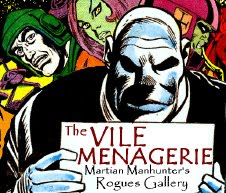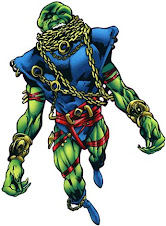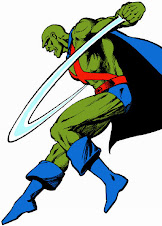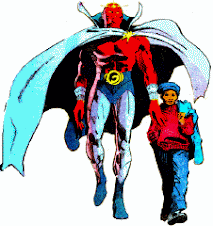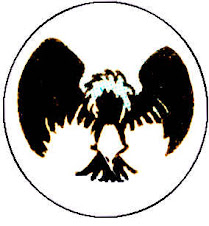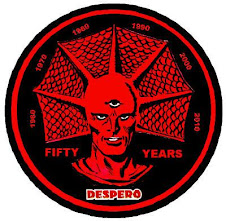
Agamemno was a yellow-skinned, symmetrically dysmorphic humanoid alien would-be conqueror created by Mark Waid to serve as the inciting antagonist for a retconned adventure set in the early days of the Justice League. You'd think he'd have learned his lesson with Triumph, but somehow Agamemno had even less staying power.
Supposedly, Agamemno's father was the first sentient being to spring from the "Big Bang," who was supposedly killed by other, lesser, jealous beings. At least, that's the story Agamemno told Lex Luthor, as he appeared before the corrupt businessman upon arriving on Earth. Agamemno lacked a physical form, and so would animate whatever matter was handy to create a simulacrum of himself for corporeal affairs of that type. Agamemno sought beings powerful enough to help him exact revenge for his father's death, and the terran Justice League of America appeared to be the perfect candidates. However, they didn't appear to be morally aligned for such a matter, so Agamemno offered to switch their essences out with terrestrial criminals, so long as they were willing to serve his ends.
Small groupings of villains associated with the League or its individual members ganged up on our heroes to facilitate the body swaps. Black Manta and Dr. Light staged an attack on Atlantis, drawing the attention of Aquaman and the Martian Manhunter...
"Thanks for responding to my JLA signal, J'Onn. Under the circumstances, two on two seems fair!"
"My pleasure, Arthur! This shouldn't take long!"

Unbeknownst to them, Agamemno was waiting in the wings with a fourth fiend, Mr. Element. "According to Agamemno, fire is the Martian's weakness! He no doubt believes he's safe from flame on the ocean's floor-- but with my weapon, I can turn that nearby coral-- into pure sodium, which burns burns underwater!" The crook next extracted the oxygen from the water around the Sea King, suffocating him unconscious. Black Manta observed, "Make a note, Light. From this point on-- you might want to lay off the matches!" Similarly, Superman, Batman, Black Canary, Flash, Green Lantern, Atom, and Green Arrow body swapped with their corresponding adversaries Luthor, the Penguin, Catwoman, Element, Sinestro, Chronos, and Felix Faust.
The displaced Leaguers were secured at their Secret Sanctuary with the help of a duped Snapper Carr. However, "Felix Faust" was able to create a bow with a spent umbrella of "The Penguin," then guide "Catwoman" in firing a trick arrow he's secured before the body swap (as Faust's eyesight was comparatively poor.) The resulting explosion helped the team gain access to Sinestro's power ring, and then freedom.
Batman/Penguin decided that the team's best course of action was to swiftly ruin the reputation of the Justice League, to put Earth on guard against its former protectors. J'Onn J'Onzz bemoaned that rolling back his and Superman's efforts at acceptance by the planet, but deferred to the Dark Knight. Meanwhile, Snapper Carr called in the reserves to help him recover the missing "villains," including the Teen Titans, the Challengers of the Unknown, Metamorpho, Elongated Man, the Doom Patrol, and the Blackhawk Squadron...
"Pawns of the Invincible Immortal!" was by Mark Waid, Terry and Rachael Dawson. Silver Age was a minor event running throughout a publication month involving one shots that helped re-secure trademarks for a bunch of old DC titles while piggybacking relatively moribund period properties onto the success of
JLA. This story was fine, I guess. It was never my bag, obviously, and it still bums me out that three Leaguers got stuck with villains that were not from their rogues gallery. I'm sure that was a concern both commercially and for expediency, since it would have eaten up a lot of pages to explain who, say, the Human Squirrel, the Ape Archer, and Socks Slade were.




 2016 Martian Manhunter - John Jones detective sketch card art by Brendon & Brian Fraim
2016 Martian Manhunter - John Jones detective sketch card art by Brendon & Brian Fraim




